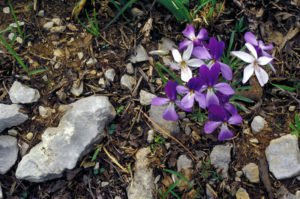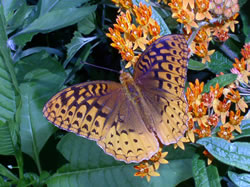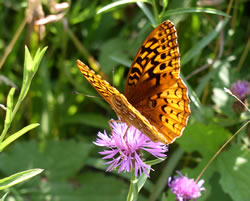Violets creep into my gardens every year. While I never considered them one of the worst weeds, I would remove them when cleaning up the garden.
No longer.
 I recently discovered that native violets are the prime host plant for many of the Fritillary caterpillars. Fritillary butterflies are marvelous members of any garden being both beautiful and good pollinators.
I recently discovered that native violets are the prime host plant for many of the Fritillary caterpillars. Fritillary butterflies are marvelous members of any garden being both beautiful and good pollinators.
But before we stray too far, a note about violets.
More than 87 species of violets are native to North America and as many as 600 are found worldwide. Many violets grow in Maryland’s Piedmont region. There are nine species of white violets according to the Mid Atlantic Nature blog and 34 species of blue violets.
Violets vary greatly in size. There is even a violet shrub. Some are perennials, others are annuals. A few are endangered; others are flourishing. If they grow too vigorously in your garden, they are easy to keep in check. You can also use them for ground cover in wooded areas or have them in a corner of your garden.
But why all of the emphasis on violets? Fritillary butterflies.
Many Fritilarries, some of whom look like Monarchs to the untrained eye, are orange and black, according to Beatriz Moisset of the U.S. Forest Service. While they may be the same size as the regal Monarchs, the patterns on their wings are different. Some specises are endanged. Fritillaries can be difficult to distinguish from one another especially in flight.
 Fritillaries are typically divided into two groups: Greater and Lesser, according to the North American Butterfly Association. Greater fritillaries are the larger of the two, as the name implies
Fritillaries are typically divided into two groups: Greater and Lesser, according to the North American Butterfly Association. Greater fritillaries are the larger of the two, as the name implies
Like many butterflies, Greater fritillary caterpillars are very picky about what they eat. They feed exclusively on violets, their host plant. Butterflies lay their eggs on the host plant and their caterpillars eat its leaves. There are approximately 14 species of Greater fritillaries (genus Speyeria).
There are 16 species of Lesser fritillaries (genus Bolloria). Lesser fritillaries use violet plants as a food source for their caterpillars but rely on other plants as host plants. Violets are not a nectar source for the Lesser fritillary.
“Without violets, there would be no fritillaries,” says Moisset.
 The adult butterflies do drink nectar from other flowers in your garden. Native plants such as mints, butterfly weed, common milkweed, and Joe-pye weed are all favored by them. They will also visit non-native flowers such as lilacs, butterfly bushes, and some non-native thistles, says Moisset. They prefer long tubular flowers but will also use some more open flowers if they are easy to reach.
The adult butterflies do drink nectar from other flowers in your garden. Native plants such as mints, butterfly weed, common milkweed, and Joe-pye weed are all favored by them. They will also visit non-native flowers such as lilacs, butterfly bushes, and some non-native thistles, says Moisset. They prefer long tubular flowers but will also use some more open flowers if they are easy to reach.
During the summer, the butterflies mate. Some females take a nap for several weeks afterwards before laying their eggs near a patch of violets.
For the sake of the fritillaries, the next time you see a violet in your garden, you may want to leave it be.
Photos top to bottom:The Birdfoot violet has been called the “queen” of all violets for its beautiful colors and leaves that look like a bird’s foot. It is native to the Eastern half of the U.S. Photo by Thomas G. Barnes, University of Tennessee Herbarium.
Fritillaries search for nectar. Photos by Beatriz Moisset, USDA Forestry Service.
